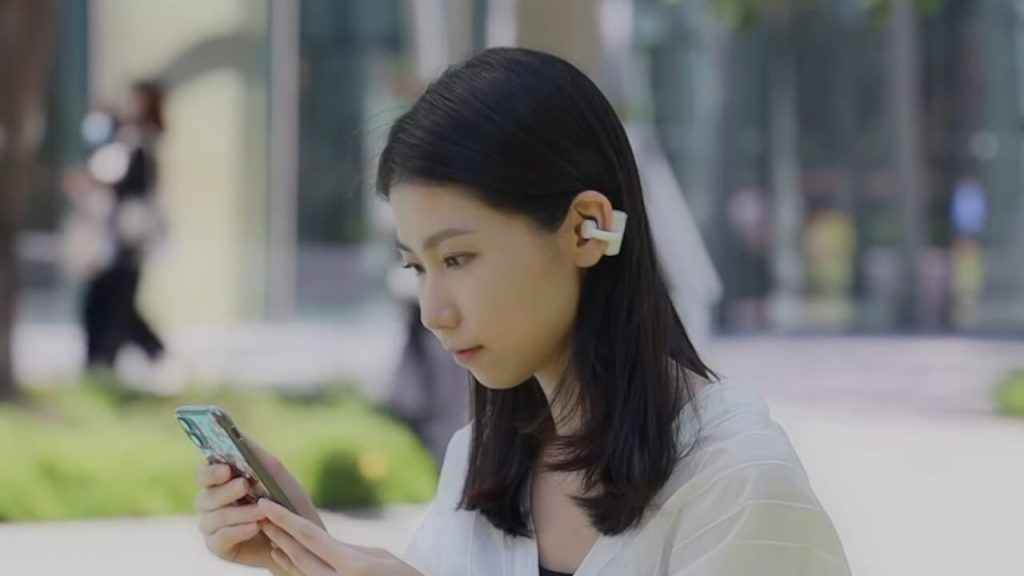Bone conduction headphones have been a surprisingly significant technological leap. Using the same technology as most common hearing aids, it has proven itself as an excellent way to listen to music without blocking your ears. But it has limitations, such as lower sound quality, which has led many people to ask, “Am I wearing my bone conduction headphones correctly?”
Different models of bone conduction headphones can be worn differently, but there are two primary ways to wear them. The hanging-ear method is the most popular. It lets the headphones hook over your ears, supported by a neckband, while the clip-on method has two earbuds that clip over your ears.
The wearing method you use will depend on the type of bone conduction headphones you have. It’s not something you can change as you please. Both methods also have some features that might make you prefer one over the other, so let’s look more closely at the two ways to wear bone conduction headphones.

The Hanging-Ear Method for Bone Conduction Headphones
The hanging-ear method is the most popular way to wear bone conduction headphones. Unlike those meant for the clip-on method, these headphones usually ship as a single unit, with the two transducers (bone conduction headphones’ replacements for speakers) connected by a band that usually rests around the listener’s neck.
This form factor is popular because it’s the shape used by Shokz (formerly Aftershokz), the company known for bringing bone conduction headphones technology into the mainstream.
To wear bone conduction headphones with the over-ear method, you place the unit over your head from the back until the strap or band rests on your neck. Now, bring the transducers forward towards the front of your ears and hook the ear hooks over your ears. The transducers should press firmly into your temple, and the ear hooks will ensure they remain in position while you’re active.
Pros and Cons of the Hanging-Ear Method
The hanging-ear method has been refined and improved for over a decade to ensure optimal performance and comfort, but it’s not perfect.

On the plus side, most people find it the most comfortable way to wear bone conduction headphones. The transducers shouldn’t press into your skull so firmly that it causes discomfort, and the ear hooks are usually small but sturdy enough to wear your headphones comfortably, even when wearing glasses or sunglasses.
On the negative side, these headphones don’t always apply enough pressure to your skull to ensure proper sound quality since a firmer grip ensures better sound. However, most models are somewhat adjustable, so you can increase or decrease the pressure if you prefer.
Depending on the size and shape of your ears, they can also be somewhat flimsy when you’re very active. Again, this is something you can adjust, and the band running around your neck should also add some stability, but finding the sweet spot between stability and comfort can be challenging.
The Clip-On Method
Bone conduction headphones that can be worn using the clip-on method are easily recognizable. They come as two separate earbuds, like AirPods, but without speakers, and they aren’t meant to go inside your ears.
These earphones are generally small, with tiny hooks that fit over your ears. They have a large bulb that fits behind your ear to add stability and pressure, while the vibration unit sits firmly against the bones of your auricle (outer ear). Apart from adding stability, the bulb usually houses the earphones’ controls and batteries.

A good example of clip-on bone conduction earphones is the EarsOpen Peace TW-1, a lightweight bone conduction model with excellent water resistance, rated at IPX7, though it has no dust resistance.
Pros and Cons of the Clip-On Method
The clip-on method isn’t the most popular way to wear bone conduction headphones, and it’s far from perfect, but it has some advantages over the hanging-ear method that could convince some people to use it.
The main advantage is that it sits very firmly. Because the bulb creates a counterbalance and adds direct pressure, the earphones are generally very stable and hard to shake off, even when you’re very active.
The added pressure also presses the transducers more firmly into your auricle, and, as we’ve seen, a firmer grip lets the vibrations travel more efficiently through your skull and to your inner ears. This means you could get a fuller sound and better volume from clip-on bone conduction headphones.
But that also comes with a significant disadvantage: discomfort. The added pressure, not to mention the bulb sitting behind your ear, can press into your ears and get uncomfortable within an hour or two. This depends on the model and the shape of your ears, but it’s a common complaint with clip-on bone conduction headphones.
This can get even worse if you’re wearing glasses or sunglasses with your clip-on earphones. Though the ear hooks are generally small, the bulbs could interfere with your glasses in uncomfortable ways.
Tips for Wearing Bone Conduction Headphones
Now that we understand the two basic ways to wear bone conduction headphones let’s look at some ways you can improve the experience.
- Shop around. Don’t just settle for the first model you see; take some time and try different options. Take your glasses or sunglasses with you when you go shopping so you can find the one that sits most comfortably.
- Position them correctly. The transducers should sit on your cheekbones, temples, or the front of your auricle (depending on the model), not “somewhere close.” The closer you get the transducers to the proper position, the better the headphones will sound, so adjust them until you find a perfect fit.
- Apply enough pressure. If the transducers don’t make proper contact, you could lose some sound quality and volume. Ensure that they sit tight enough but without causing discomfort. This takes some tampering and a few adjustments.
- Keep obstacles away. Anything that gets in the way of ensuring a tight fit will also affect how well the transducers can vibrate against your skull. This includes glasses (it’s generally helpful to put on the headphones before your glasses) and even hair, so if you have long hair, move it all away before putting on your headphones.
- Use earplugs. One of the most significant problems with bone conduction headphones is their volume. You perceive the volume to be much lower than it is, but that’s because of the open-ear design. If you want better quality and volume and don’t need environmental awareness at that moment, wearing earplugs will make a massive difference.
- Prioritize. Because of the differences between the clip-on and hanging-ear methods, choosing bone conduction headphones usually involves some compromise on comfort or quality. Choose which is more important to you in your situation. The differences aren’t as significant as they used to be, and devices will likely improve even more, but it’s still an important consideration.
Conclusion
Bone conduction headphones can usually be worn in either hanging-ear or clip-on methods. Hanging-ear is the most popular (and comfortable), so it’s how most manufacturers intend users to wear their headphones. The clip-on method often sacrifices some comfort, especially when you wear them for several hours, but they usually offer slightly better quality and volume.

